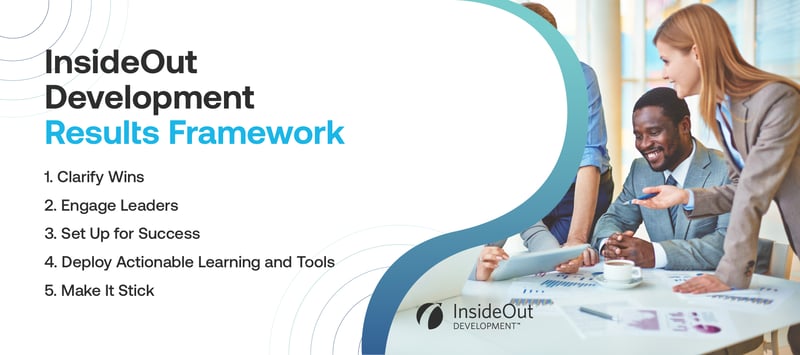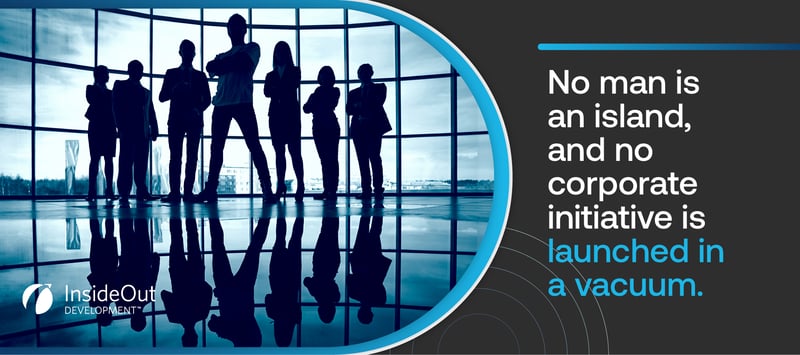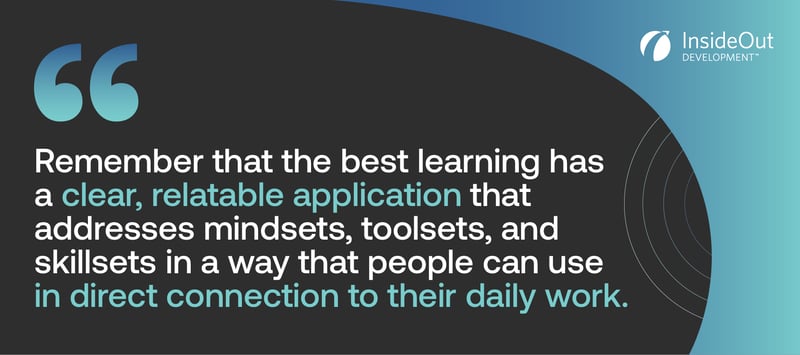At InsideOut Development, we've had the genuine privilege of working with hundreds of organizations and thousands of individuals who are looking to improve their performance. Based on decades of experience, we've designed a simple, five-step process that we call the Results Framework.
What Is the Results Framework?
The InsideOut Development Results Framework is an effective decision-and-action structure. It provides business leadership with the steps necessary to guide them during the implementation of a corporate initiative. It becomes particularly useful when leaders may be trying to establish credibility or need to manage a change within the organization.
The main purpose of each step within the framework is to focus on results, turning learning- and performance-based business initiatives into results-driven actions, and enabling a domino effect for all other corporate initiatives.
5 Steps of the Results Framework

The five steps within the InsideOut Development Results Framework are clarifying wins, engaging leaders, setting up for success, deploying actionable learning and tools, and making it stick.
1. Clarify Wins
The first step in the Results Framework is to provide clarification on wins. There are three components to this step: determining business wins, quick wins, and personal wins.
Business wins emphasize the desired outcomes within the organization, team, or business unit. Quick wins are those early indicators of success on the road to the bigger, larger win — the goal. Personal wins are things important to each member of the team, regardless of their current title.
Questions to ask while in the clarifying wins step include:
- What is the one outcome we are seeking to achieve as a team, business unit, location, or organization?
- What are the early indicators (usually at the individual level) that the initiative will be successful?
- What can be gained by the individuals at the personal level if they achieve the goals within the initiative?
2. Engage Leaders
The second step is similar to the first and focuses on engaging leadership. To engage leadership, there are three critical areas required: getting sponsorship, getting alignment, and getting members of leadership modeling.
To gain sponsorship, major stakeholders and management need to accept the initiative and see that it has merit. This is often accomplished by showing the positive impact the initiative or change will bring about.
After gaining sponsorship, you can encourage alignment by discussing the wins that were identified during step one. Also, clearly define the expectations of leadership and management, so that they will be more likely to model the change you are trying to achieve.
Actions and strategies that have worked for InsideOut Development's clients include:
- Consistently communicating leader roles and providing training and support for their duties, especially those directly related to the change or initiative
- Drafting kick-off remarks for leaders and having these leaders provide introductions for key events
- Involve leaders in a group application of GROW®, focusing on the leader role to drive results
3. Set Up for Success

No man is an island, and no corporate initiative is launched in a vacuum. Step three emphasizes relevance, systematic preparation, and thorough communication.
- The most successful initiatives are those that are relevant to the overall needs, goals, and objectives of the organization.
- Systematic preparation requires consideration of what will be required of all team members before, during, and after the change or initiative occurs.
- Thorough communication involves transparent and clear messaging of the wins that happen as well as specific expectations.
Ensuring your initiative is relevant to your organization's needs, goals, and objectives is the most vital component of step three and requires being able to answer these questions:
- What are the connections you can make to how work is done today, and what needs to change?
- What obstacles could impede success?
- How will you countermeasure to ensure that your efforts have the desired impact?
4. Deploy Actionable Learning and Tools
In step four of the Results Framework, the focus is on the learning and tools that are often part of a new company initiative.
As actionable learning and tools are implemented, the goal should be to make this training engaging, motivating, and impactful. This can often be accomplished by accommodating various learning strategies and styles.
Remember that the best learning has a clear, relatable application that addresses mindsets, toolsets, and skillsets in a way that people can use in direct connection to their daily work. The targeted behavior change and tools need to be seen simply as the way work is done, rather than being additional work.

When deploying actionable learning and tools, as well as introducing new concepts and procedural changes, what has worked for some of InsideOut Development's clients include:
- Involving leaders with kick-off events and attendance during initial training
- Ensuring job aids and references are accessible, easy to use, and relevant
- Communicating clear expectations for post-workshop/post-training activities
5. Make It Stick
There are three key actions in the final step of the Results Framework that will help ensure your initiative has staying power and gets results: leader check-in, simple tracking, and timely recognition and rewards.
A leader check-in is a conversation with the goal of productive dialogue that is targeted toward driving alignment, focus, self-reflection, and self-correction.
Tracking the achievement of wins keeps everyone informed of the progress that is being made. Tracking should be simple and focused on participation as well as the results being achieved that are most important to the organization.
Finally, reinforce the change or initiative by making recognition and reward an ongoing part of the process. Share examples and success stories as often as possible, including during regularly scheduled meetings — whether daily or weekly. Whatever your organization's chosen method of recognition, it should be timely, specific, and frequent.
InsideOut Development Results Framework: Simplicity in Action
If the Results Framework seems clear and uncomplicated, that's because it was designed with simplicity and adaptability at the forefront.
We believe people can achieve better results by taking action on what they already know. Whether you're launching a solution from InsideOut Development or working on becoming a force for change within your organization, the Results Framework is a powerful tool.
If you’d like to know more about what incorporating the InsideOut Results Framework would look like for your organization — or yourself — get in touch with a member of our coaching staff so we can discuss specific solutions for your executive coaching needs.




-03.jpg?width=322&name=Why%20Most%20Leadership%20Programs%20Do%20Not%20Work%20(And%20What%20to%20Do%20About%20It)-03.jpg)
